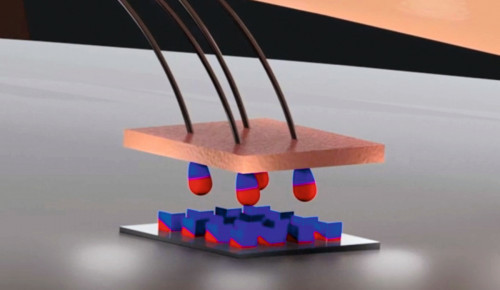A research team from Chemnitz and Dresden has taken a major step forward in the further development of sensitive electronic skin (e-skin) with integrated hairs.
While it is usually possible to feel the slightest touch of the hairs on the arm and also assign the direction of the touch, it has not yet been technologically possible to detect the direction of tactile influences on e-skin surfaces. The fields of application range from skin substitutes and applications as medical sensors on the body to artificial skin for human-like machines such as humanoid robots and androids.
 Artificial electronic skin (e-skin): Using the micro-origami method, many microelectronic components fit into a very small space. (Source: TU Chemnitz)A research team led by Prof. Dr. Oliver G. Schmidt, Chair of Materials Systems in Nanoelectronics and Scientific Director of the Center for Materials, Architectures and Integration of Nanomembranes (MAIN) at Chemnitz University of Technology, has now presented a method for developing an extremely sensitive unit of direction-dependent magnetic 3D sensors that can be integrated into an e-skin system. They report on their results in the current issue of the renowned journal "Nature Communications".
Artificial electronic skin (e-skin): Using the micro-origami method, many microelectronic components fit into a very small space. (Source: TU Chemnitz)A research team led by Prof. Dr. Oliver G. Schmidt, Chair of Materials Systems in Nanoelectronics and Scientific Director of the Center for Materials, Architectures and Integration of Nanomembranes (MAIN) at Chemnitz University of Technology, has now presented a method for developing an extremely sensitive unit of direction-dependent magnetic 3D sensors that can be integrated into an e-skin system. They report on their results in the current issue of the renowned journal "Nature Communications".
The core of the sensor system is a so-called anisotropic magnetoresistive sensor (AMR). An AMR can be used to precisely determine changes in magnetic fields.
To develop their highly compact sensor system, the researchers used the so-called "micro-origami method". This method is used to automatically unfold several AMR sensor components on a chip into a three-dimensional cube structure that can resolve the magnetic vector field. With the micro-origami method, many microelectronic components fit into a very small space with geometries that cannot be realized with conventional microchip manufacturing processes.
The research team integrated the micro-origami magnetic sensors into an active electronic matrix with which each individual sensor element can be conveniently addressed and read out by electronic circuits. In addition, the research team succeeded in integrating the 3D magnetic field sensors with extremely fine artificial hairs into an artificial skin. The hairs were each equipped with a magnetic root. The skin consists of an elastic polymer matrix into which electronics and sensors have been integrated. This is similar to real organic skin, in which the nerves and sensory cells are embedded.
Publication: C. Becker et al. A new dimension for magnetosensitive e-skins: active matrix integrated micro-origami sensor arrays. Nat. Comm. 13, 2121 (2022).


